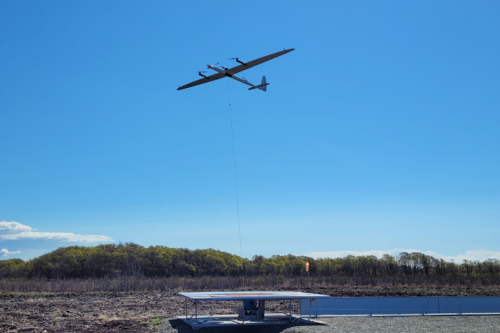Using drones to harvest wind energy could play a significant role in the UK’s net-zero mission.
University of Bristol’s Lecturer in Flight Dynamics and Control Dr Duc H. Nguyen has landed a £375,000 grant from the Engineering and Physical Sciences Research Council (EPSRC) to conduct further research into the emerging field of Airborne Wind Energy Systems (AWES).
By tethering a drone to a ground station, AWES harvests wind power at higher altitudes than conventional wind turbines. The high wind pulls the drone away from the ground station, driving the generator, and producing electricity.
This technology can benefit the UK’s energy sector by reducing its carbon footprint, providing offshore and onshore flexibility, and enhancing the ability to operate in remote areas.
To generate the most power, AWES must fly in intricate patterns while subjected to strong aerodynamic forces. This arrangement creates a complex system with delicate handling characteristics – a slight miscalculation could send the drone tumbling to the ground.
This is the challenge that Dr Nguyen and his collaborators hope to solve during this project. By improving AWES safety and efficiency, he hopes the project will pave the way for AWES commercialisation.
Dr Nguyen, from the School of Civil, Aerospace and Design Engineering, explained: “Airborne wind energy has enormous potential and is anticipated to generate €70 billion per year worth of electricity by 2050.”
“However it is still an emerging technology. In many cases, a trade-off has been made: new designs have been rapidly deployed for test flights before their flying characteristics are fully understood. This has prevented many AWES prototypes from achieving full capacity in operation, leading to early termination of the programme and hindering commercialisation.
“This project seeks to address this challenge through the use of bifurcation and continuation methods.”
These numerical techniques have been successfully used in aircraft dynamic studies to predict dangerous behaviours such as pilot-induced oscillation, flutter, and spin.
Dr Nguyen concluded: “By replacing existing techniques with bifurcation methods, AWES can achieve significant cost savings and improved performance that will ultimately bring this technology closer to commercialisation.”
In addition to the EPSRC funding, the project also benefits from collaborations with two leading players in the sector, Norwegian startup Kitemill and University Carlos the III of Madrid.
Thomas Hårklau, co-founder and Chief Executive Officer of Kitemill, added: “The initiation and successful funding of this AWES project is an important development in the renewable energy sector. AWES technology, with its exceptional material efficiency and higher energy yields, has the potential to become a dominant force in the energy industry.
“We are excited to collaborate with Duc Nguyen and Bristol University on this initiative. This project not only advances the UK’s net-zero mission but also secures British competence in this emerging sector. Together, we aim to address current challenges and pave the way for the commercialisation of AWES.”

